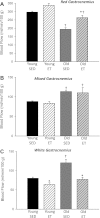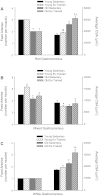Effects of aging and exercise training on skeletal muscle blood flow and resistance artery morphology
- PMID: 23042906
- PMCID: PMC3544508
- DOI: 10.1152/japplphysiol.01025.2012
Effects of aging and exercise training on skeletal muscle blood flow and resistance artery morphology
Abstract
With old age, blood flow to the high-oxidative red skeletal muscle is reduced and blood flow to the low-oxidative white muscle is elevated during exercise. Changes in the number of feed arteries perforating the muscle are thought to contribute to this altered hyperemic response during exercise. We tested the hypothesis that exercise training would ameliorate age-related differences in blood flow during exercise and feed artery structure in skeletal muscle. Young (6-7 mo old, n = 36) and old (24 mo old, n = 25) male Fischer 344 rats were divided into young sedentary (Sed), old Sed, young exercise-trained (ET), and old ET groups, where training consisted of 10-12 wk of treadmill exercise. In Sed and ET rats, blood flow to the red and white portions of the gastrocnemius muscle (Gast(Red) and Gast(White)) and the number and luminal cross-sectional area (CSA) of all feed arteries perforating the muscle were measured at rest and during exercise. In the old ET group, blood flow was greater to Gast(Red) (264 ± 13 and 195 ± 9 ml · min(-1) · 100 g(-1) in old ET and old Sed, respectively) and lower to Gast(White) (78 ± 5 and 120 ± 6 ml · min(-1) · 100 g(-1) in old ET and old Sed, respectively) than in the old Sed group. There was no difference in the number of feed arteries between the old ET and old Sed group, although the CSA of feed arteries from old ET rats was larger. In young ET rats, there was an increase in the number of feed arteries perforating the muscle. Exercise training mitigated old age-associated differences in blood flow during exercise within gastrocnemius muscle. However, training-induced adaptations in resistance artery morphology differed between young (increase in feed artery number) and old (increase in artery CSA) animals. The altered blood flow pattern induced by exercise training with old age would improve the local matching of O(2) delivery to consumption within the skeletal muscle.
Figures






References
-
- Armstrong RB, Hayes DA, Delp MD. Blood flow distribution in rat muscles during preexercise anticipatory response. J Appl Physiol 67: 1855–1861, 1989 - PubMed
-
- Armstrong RB, Laughlin MH. Exercise blood flow patterns within and among rat muscles after training. Am J Physiol Heart Circ Physiol 246: H59–H68, 1984 - PubMed
-
- Babcock MA, Paterson DH, Cunningham DA. Effects of aerobic endurance training on gas exchange kinetics of older men. Med Sci Sports Exerc 26: 447–452, 1994 - PubMed
-
- Beere PA, Russell SD, Morey MC, Kitzman DW, Higginbotham MB. Aerobic exercise training can reverse age-related peripheral circulatory changes in healthy older men. Circulation 100: 1085–1094, 1999 - PubMed
Publication types
MeSH terms
Substances
Grants and funding
LinkOut - more resources
Full Text Sources
Other Literature Sources
Medical
Miscellaneous

